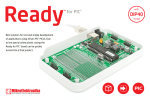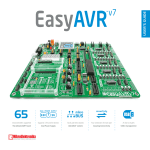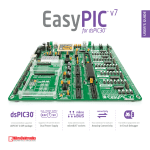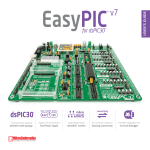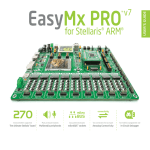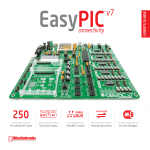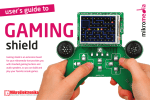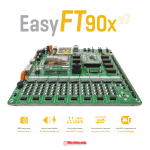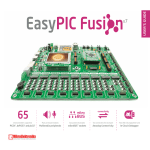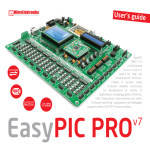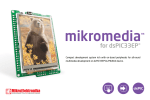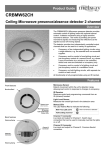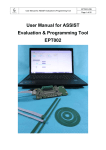Download mikromedia workStation User Manual
Transcript
v7 for PIC18FJ®, dsPIC33®, PIC24® and PIC32® 6 mikromedia boards supported PIC18FJ®,dsPIC33®/PIC24® and PIC32® Many on-board modules Multimedia peripherals Easy-add extra boards mikroBUS™ sockets Four connectors for each port Amazing Connectivity Fast USB 2.0 programmer and In-Circuit Debugger USER'S GUIDE workStation mikromedia To our valued customers mikromedia™ has developed into a well-known brand. Not only that we set new standards in design and selection of on-board modules, but we also created an entire ecosystem of users who use our visual tools and compilers to develop TFT applications faster and easier than ever before. The ease of use is our top priority. This is why we wanted to take things to the next level. mikromedia™ workStation v7 is unlike anything you have seen before. With custom pin markings it will revolutionize the way people look at different architectures. Switching from one mikromedia to another while using virtually the same code is a very powerful concept. We are confident this will be especially interesting in education and among developers who need flexibility and rapid prototyping. Nebojsa Matic, Owner and General Manager of mikroElektronika Table of contents Introduction Connectivity Introduction . . . . . . . . . . . . . . . . . . . . . . . . . . . . . . . . . . . . . . . 04 Input/Output Group . . . . . . . . . . . . . . . . . . . . . . . . . . . . . . . 24 It's good to know . . . . . . . . . . . . . . . . . . . . . . . . . . . . . . . . . . 05 mikroBUS™ sockets . . . . . . . . . . . . . . . . . . . . . . . . . . . . . . . 26 Click Boards™ are plug and play . . . . . . . . . . . . . . . . . . . . 27 Power Supply Power supply . . . . . . . . . . . . . . . . . . . . . . . . . . . . . . . . 06 Communication How to power the board?. . . . . . . . . . . . . . . . . . . . . . . . . 07 UART via RS-232 . . . . . . . . . . . . . . . . . . . . . . . . . . . . . . . . . 28 UART via USB . . . . . . . . . . . . . . . . . . . . . . . . . . . . . . . . . . . . . 29 mikromedia mikromedia™ board socket . . . . . . . . . . . . . . . . . . . . . . . . . 08 How to properly place into the socket? . . . . . . . . . . . . . 10 What is mikromedia™ board?. . . . . . . . . . . . . . . . . . . . . . . . 11 Navigation switch . . . . . . . . . . . . . . . . . . . . . . . . . . . . . . . . . 30 Which one to use? . . . . . . . . . . . . . . . . . . . . . . . . . . . . . . . . . 12 Audio module . . . . . . . . . . . . . . . . . . . . . . . . . . . . . . . . . . . . . 31 BSP makes programming easier . . . . . . . . . . . . . . . . . . . 14 DS1820 - Digital Temperature Sensor . . . . . . . . . . . . . . 32 Package Manager . . . . . . . . . . . . . . . . . . . . . . . . . . . . . . . . . 16 LM35 - Analog Temperature Sensor . . . . . . . . . . . . . . . . 33 Installing BSP libraries . . . . . . . . . . . . . . . . . . . . . . . . . . . . . 17 ADC inputs . . . . . . . . . . . . . . . . . . . . . . . . . . . . . . . . . . . . . . . . 34 Piezo Buzzer . . . . . . . . . . . . . . . . . . . . . . . . . . . . . . . . . . . . . . 35 Additional GNDs . . . . . . . . . . . . . . . . . . . . . . . . . . . . . . . . . . . 36 Breadboard area . . . . . . . . . . . . . . . . . . . . . . . . . . . . . . . . . . 37 Programmer/debugger Other modules On-board programmer . . . . . . . . . . . . . . . . . . . . . . . . . . . . . 18 Installing programmer drivers . . . . . . . . . . . . . . . . . . . . . . 20 Programming software . . . . . . . . . . . . . . . . . . . . . . . . . . . . 21 What's Next? mikroICD™ - In Circuit Debugger . . . . . . . . . . . . . . . . . . . 22 What’s Next? . . . . . . . . . . . . . . . . . . . . . . . . . . . . . . . . . . . . . . 38 page 3 introduction Introduction After several years of successful production of mikromedia™ boards, we have decided to delight users of our products and make a new development system that expands functionality of all mikromedia™ boards with Microchip® microcontrollers. The idea was to make a development system with as many peripherals as possible to cover multimedia modules. On the other hand we wanted to fit in dimensions of other development systems with 2-layer PCB. We present you the board which is powerful, well organized, with high-quality components, on-board programmer and debugger and it's ready to be your strong ally in development. We hope you will enjoy it as much as we do. mikromedia™ workStation v7 Development Team Supports all Microchip® mikromedias It’s like the body for the brain Debugger on board For easier connections Perfect for education mikromedia with wires Debugger on board Four mikroBUS sockets This is a perfect tool for education. Since board supports mikromedia boards for PIC18®, dsPIC®, PIC24® and PIC32®, you can easily switch to one you need in your development. Workstation helps you to connect your mikromedia board to the rest of the world. Button, LED and four headers for each pin are the arsenal you need. mikromedia becomes the brain of your device. Powerful on-board mikroProg™ programmer and In-Circuit debugger can program and debug all supported mikromedias. Once you use it, you won’t be able to imagine a development without it. Not two, not three but four different mikroBUS host sockets enable you to do do whatever you imagine. Simply snap in your Click board, and add a whole new functionality. page 4 introduction It's good to know System Specifications power consumption ~135 mA (all modules are disconnected) power supply 7–23V AC or 9–32V DC or via USB cable (5V DC) weight 515 g (1.135 lbs) board dimensions 266 x 220 mm (10.47 x 8.66 inch) Package contains 1 Damage resistant protective box 2 mikromedia™ workStation v7 board for PIC® 3 USB cable 4 Wire jumpers 20122011 www.mikroe.com Copyright ©2011 Mikroelektronika. All rights reserved. Mikroelektronika, Mikroelektronika logo and other Mikroelektronika trademarks are the property of Mikroelektronika. All other trademarks are the property of their respective owners. Unauthorized copying, hiring, renting, public performance and broadcasting of this DVD prohibited. 5 User Manual 6 Board schematic 7 mikroProg Suite™ and mikroICD™ manuals 8 DVD with examples and documentation page 5 power supply Power supply Board contains switching power supply that creates stable voltage and current levels necessary for powering each part of the board. Power supply section contains specialized MC33269DT3.3 power regulator which creates VCC-3.3V power supply, thus making the board capable of supporting 3.3V microcontrollers. Power supply unit can be powered in three different ways: with USB power supply (CN5), using external adapters via adapter connector (CN36) or additional screw terminals (CN35). External adapter voltage levels must be in range of 9-32V DC and 7-23V AC. Use jumper J1 to specify which power source you are using. Upon providing the power using either external adapters or USB power source you can turn on power supply by using SWITCH 1 (Figure 3-1). Power LED ON (Green) will indicate the presence of power supply. Figure 3-1: Power supply unit of mikromedia™ workStation v7 POWER 1 3 VCC-5V GND Vin 2 Vout C20 100nF C21 100nF CN5 VCC 1 VCC-3.3V MC33269DT3.3 E6 220uF/35V/LESR VCC-USB VCC-5V REG1 FP1 LD1 ON/OFF E5 10uF C5 100nF R28 2K2 GND4 USB 3.3V VOLTAGE REGULATOR VCC-5V 3 2 1 SWITCH1 U5 VCC-USB 1 VCC-SW L1 220uH 2 J1 3 E7 220uF/35V/LESR D5 MBRS140T3 C22 220pF 4 SWC DRVC SWE IPK CT VIN GND CMPR MC34063A 5V SWITCHING POWER SUPPLY 8 R29 0.22 D1 CN36 5 + VCC-EXT 6 VCC-SW R30 3K E8 220uF/35V /LESR R31 1K Figure 3-2: Power supply unit schematic page 6 D2 7 1N4007 1N4007 D3 D4 1N4007 1N4007 - CN35 Board power supply creates stable 3.3V necessary for operation of the microcontroller and all on-board modules. Power capacity: power supply Power supply: via DC connector or screw terminals (7V to 23V AC or 9V to 32V DC), or via USB cable (5V DC) up to 500mA with USB, and up to 600mA with external power supply How to power the board? 1. With USB cable 1 2 3 4 5 6 Set J1 jumper to USB position To power the board with USB cable, place jumper J1 in USB position. You can then plug in the USB cable as shown on images 1 and 2 and turn the power switch ON. 2. Using adapter Set J1 jumper to EXT position To power the board via adapter connector, place jumper J1 in EXT position. You can then plug in the adapter cable as shown on images 3 and 4 and turn the power switch ON. 3. With laboratory power supply Set J1 jumper to EXT position To power the board using screw terminals, place jumper J1 in EXT position. You can then screw-on the cables in the screw terminals as shown on images 5 and 6 and turn the power switch ON. page 7 mikromedia mikromedia board socket ™ mikromedia™ workStation v7 contains four female headers that together form a socket for specialized small development boards with a microcontroller and on-chip modules, called mikromedia™ boards. Two of them are used for general purpose I/O and power pins (1x26). The other two are used for the mikroProg™ programmer (1x5) or ICD2/3 (1x6). Before placing the mikromedia™ board into the appropriate socket (Page 10), you have to solder two 1x26 male headers to the side pads and one 1x5 male header for mikroProg™ programmer. Currently, six mikromedia™ boards are supported, but there is a tendency to increase the number: 1 mikromedia for PIC18FJ® 2 mikromedia for PIC24® 3 mikromedia for PIC24EP® 4 mikromedia for dsPIC33® 5 mikromedia for dsPIC33EP® 6 mikromedia for PIC32® After testing and building the final program, this mikromedia™ can also be taken out of the board socket and used in your final device which makes it a great choice for both beginners and professionals. The mikromedia™ socket schematic is shown on Figure 4-2 page 8 Figure 4-1: mikromedia™ board socket LOUT ROUT G2.4 G2.5 G2.6 G2.7 G3.0 G3.1 G3.2 G3.3 G3.4 G3.5 G3.6 G3.7 G4.0 G4.1 G4.2 G4.3 G4.4 G4.5 G4.6 G4.7 27 28 29 30 31 32 33 34 35 36 37 38 39 40 41 42 43 44 45 46 47 48 49 50 51 52 5V GND ANALOG PWM RX TX SCL SDA 3.3V GND L R GND RST INT SCK MISO MOSI 3.3V GND 1 2 3 4 5 6 7 8 9 10 11 12 13 14 15 16 17 18 19 20 21 22 23 24 25 26 mikromedia for PICI8FJ, dsPIC33,PIC24 and PIC32 mikromedia A0 A1 G0.0 G0.1 G0.2 G0.3 G0.4 G0.5 G0.6 G0.7 G1.0 G1.1 G1.2 G1.3 G1.4 G1.5 G1.6 G1.7 G2.0 G2.1 G2.2 G2.3 VCC-5V MM1 RST 3.3V GND PGD PGC NC 3.3V PGC PGD RST GND 63 62 61 60 59 58 53 54 55 56 57 MCU-VPP MCU-PGD MCU-PGC MCU-PGC MCU-PGD MCU-VPP DATA BUS Figure 4-2: mikromedia™ board socket schematic page 9 mikromedia How to properly place your mikromedia™ board into the socket? Before you plug the mikromedia™ board into the socket, make sure that the power supply is turned off. Images below show how to correctly plug the board. First make sure that mikromedia™ board orientation matches the silkscreen outline on the 1 Figure 4-3: On-board mikromedia™ socket has silkscreen markings which will help you to correctly orient the mikromedia™ board before inserting. page 10 mikromedia™ workStation v7 board socket. Place the mikromedia™ board over the socket so that each male header is properly aligned with the female socket, as shown in Figure 4-4. Then put the mikromedia™ board slowly down until all the pins match the 2 Figure 4-4: Place the mikromedia™ board in the socket so that pins are aligned properly. socket (make sure you don't push the screen). Check again if everything is placed correctly and press the mikromedia™ board until it is completely plugged into the socket as shown in Figure 4-5. Now you can turn the power supply on. 3 Figure 4-5: Properly placed mikromedia™ board. What is mikromedia board? The mikromedia™ board is a compact development system with lots of on-board peripherals which allow development of devices with multimedia content. The central part of the system is a PIC18FJ®, PIC24®, dsPIC33® or PIC32® microcontroller, depending on mikromedia™ board. The mikromedia™ features integrated modules such as Audio module (with stereo MP3 codec and 3.5mm audio connector for headphones), resistive TFT 320x240 touch screen display (with 262.144 10 different colors), battery charger, accelerometer, microSD card slot and 8 Mbit flash memory. mikromedia™ board also contains a MINI-B USB connector, two 1x26 connection pads, LI-Polymer battery connector and other. It comes pre programmed with bootloader, but can also be programmed with standalone programmers, such as mikroProg™ or ICD2/3. mikromedia™ is compact and slim, and perfectly fits in the palm of your hand, which makes it a convenient platform for mobile devices. It can be powered through a 03 04 mikromedia ™ USB MINI-B cable or battery supply. When you put any of them in mikromedia™ workStation v7 system number of modules and functionality significantly increase. Key components are marked as in the example of mikromedia for PIC32® (Figure 4-6) and are similar for other mikromedia™. The most important differences between mikromedia™ boards are shown on page 12 and 13. A detailed description can be found in appropriate manuel provided with the mikromedia™ board. 01 Connection Pads 05 06 02 TFT 320x240 display 03 USB MINI-B connector 04 CHARGE indication LED 07 05 Li-Polymer battery connector 01 06 3.5mm headphone connector 08 09 10 07 Power supply regulator 08 Serial Flash memory 09 VS1053 Stereo mp3 coder/decoder 10 RESET button 11 11 microcontroller (PIC32MX460F512L) 12 02 12 Accelerometer 13 Crystal oscillator 13 14 Power indication LED 14 15 16 17 15 microSD Card Slot 16 ICD2/3 connector 17 mikroProg™ connector Figure 4-6: Key components of mikromedia for PIC32® board page 11 mikromedia Which one to use? mikromedia for PIC18FJ mikromedia for PIC24 Architecture: 8-bit CPU speed: 12 MIPS Flash memory: 128 kB RAM memory: 3,904 Bytes Operating MCU Voltage: 2 – 3.6 V USB DEVICE: Yes USB UART: No Consumption (back light is ON): 51.7 mA Back light current: 42mA Max I2C speed: 400 kHz Max microSD SPI speed: 12 MHz Max Flash memory SPI speed: 12 MHz Max Audio codec SPI speed: 3 MHz Architecture: CPU speed: Flash memory: RAM memory: Operating MCU Voltage: USB DEVICE: USB UART: Consumption (back light is ON): Back light current: Max I2C speed: Max microSD SPI speed: Max Flash memory SPI speed: Max Audio codec SPI speed: page 12 mikromedia for PIC24EP 16-bit 16 MIPS 256 kB 16 kB 2 – 3.6 V Yes No 56.2 mA 42mA 400 kHz 16 MHz 16 MHz 2 MHz Architecture: CPU speed: Flash memory: RAM memory: Operating MCU Voltage: USB DEVICE: USB UART: Consumption (back light is ON): Back light current: Max I2C speed: Max microSD SPI speed: Max Flash memory SPI speed Max Audio codec SPI speed: 16-bit 70 MIPS 512 kB 52 kB 3 – 3.6 V Yes No 57 mA 42mA 400 kHz 35 MHz 35 MHz 2.1 MHz mikromedia for dsPIC33 Architecture: CPU speed: Flash memory: RAM memory: Operating MCU Voltage: USB DEVICE: USB UART: Consumption (back light is ON): Back light current: Max I2C speed: Max microSD SPI speed: Max Flash memory SPI speed: Max Audio codec SPI speed: 16-bit 40 MIPS 256 kB 30 kB 3 – 3.6 V No Yes 59.7 mA 42mA 400 kHz 16 MHz 16 MHz 4 MHz mikromedia for dsPIC33EP Architecture: CPU speed: Flash memory: RAM memory: Operating MCU Voltage: USB: USB-UART: Consumption (back light is ON): Back light current: Max I2C speed: Max microSD SPI speed: Max Flash memory SPI speed: Max Audio codec SPI speed: 16-bit 70 MIPS 512 kB 52 kB 3 – 3.6 V Yes No 56.2 mA 42mA 400 kHz 35 MHz 35 MHz 2.1 MHz mikromedia for PIC32 Architecture: CPU speed: Flash memory: RAM memory: Operating MCU Voltage: USB DEVICE: USB UART: Consumption (back light is ON): Back light current: Max I2C speed: Max microSD SPI speed: Max Flash memory SPI speed: Max Audio codec SPI speed: 32-bit 120 MIPS 512 kB 32 kB 2.3 – 3.6 V Yes No 113 mA 42mA 400 kHz 20 MHz 40 MHz 3.33 MHz page 13 mikromedia For now we are giving you the choice to choose between 6 mikromedia boards. Each of them is specific in its own way. The main idea here is to show you comparative key features in one place, which makes it easier for you to choose. mikromedia BSP makes programming easier « Board Support Package in mikroElektronika compilers What is BSP? In embedded world, BSP or Board Support Package is the common name for all hardware-specific codes which simplifies working with the board. That is why we made a BSP package support for mikromedia™ workStation v7 board, to make programming of mikromedia™ boards much easier. Various mikromedia boards have different connections of microcontroller pins on side pads. mikromedia™ workStation v7 development system has a unique set of markings on a silk screen which enables you to use each pin connected to mikromedia™ side pads with the well organized layout, combined together into five I/O RST GND LOUT ROUT G2.4 G2.5 G2.6 G2.7 G3.0 G3.1 G3.2 G3.3 G3.4 G3.5 G3.6 G3.7 G4.0 G4.1 G4.2 G4.3 G4.4 G4.5 G4.6 G4.7 3.3V GND 5V GND A0 A1 G0.0 G0.1 G0.2 G0.3 G0.4 G0.5 G0.6 G0.7 G1.0 G1.1 G1.2 G1.3 G1.4 G1.5 G1.6 G1.7 G2.0 G2.1 G2.2 G2.3 3.3V GND mikromedia for PIC18FJ page 14 groups labeled as G0, G1, G2, G3 and G4. BSP abstracts what's "underneath the hood" and enables you to have one development system for various mikromedia™ boards. For example, pin number 5 on the side pad of mikromedia for PIC18FJ is connected to the RF2 microcontroller pin. On the other hand, pin number 5 on the side pad of mikromedia for PIC32 is connected to the RB2 microcontroller pin. BSP package and mikromedia workStation v7 offers you the possibility to use this pin with the unique name G0.0, and this stands for all PIC mikromedia boards. In addition to simple I/O functions, BSP package also provides you RST GND LOUT ROUT G2.4 G2.5 G2.6 G2.7 G3.0 G3.1 G3.2 G3.3 G3.4 G3.5 G3.6 G3.7 G4.0 G4.1 G4.2 G4.3 G4.4 G4.5 G4.6 G4.7 3.3V GND 5V GND A0 A1 G0.0 G0.1 G0.2 G0.3 G0.4 G0.5 G0.6 G0.7 G1.0 G1.1 G1.2 G1.3 G1.4 G1.5 G1.6 G1.7 G2.0 G2.1 G2.2 G2.3 3.3V GND mikromedia for PIC24 a simple way of using ADC, I2C, SPI and UART libraries without knowing, for example if it is UART1 or UART2 module connected to mikromedia™ side pads. Before using, you need to choose the appropriate BSP package depending on the programming language (C, Basic, Pascal) and the type of mikromedia (PIC18FJ®, PIC24®, PIC24EP®, dsPIC33®, dsPIC33EP®, PIC32®). BSP can only be used with Mikroelektronika compilers. If you use other compilers or if you do not want to use BSP, connections between mikromedia™ side pads and workStation board pins are as shown on the images below. RST GND LOUT ROUT G2.4 G2.5 G2.6 G2.7 G3.0 G3.1 G3.2 G3.3 G3.4 G3.5 G3.6 G3.7 G4.0 G4.1 G4.2 G4.3 G4.4 G4.5 G4.6 G4.7 3.3V GND 5V GND A0 A1 G0.0 G0.1 G0.2 G0.3 G0.4 G0.5 G0.6 G0.7 G1.0 G1.1 G1.2 G1.3 G1.4 G1.5 G1.6 G1.7 G2.0 G2.1 G2.2 G2.3 3.3V GND mikromedia for PIC24EP mikromedia Install board support package (BSP) in 3 simple steps: 1. Download package from libstock website RST GND LOUT ROUT G2.4 G2.5 G2.6 G2.7 G3.0 G3.1 G3.2 G3.3 G3.4 G3.5 G3.6 G3.7 G4.0 G4.1 G4.2 G4.3 G4.4 G4.5 G4.6 G4.7 3.3V GND 5V GND A0 A1 G0.0 G0.1 G0.2 G0.3 G0.4 G0.5 G0.6 G0.7 G1.0 G1.1 G1.2 G1.3 G1.4 G1.5 G1.6 G1.7 G2.0 G2.1 G2.2 G2.3 3.3V GND mikromedia for dsPIC33 2. Install it with Package manager software 3. Use it as a library in mikroE compilers RST GND LOUT ROUT G2.4 G2.5 G2.6 G2.7 G3.0 G3.1 G3.2 G3.3 G3.4 G3.5 G3.6 G3.7 G4.0 G4.1 G4.2 G4.3 G4.4 G4.5 G4.6 G4.7 3.3V GND 5V GND A0 A1 G0.0 G0.1 G0.2 G0.3 G0.4 G0.5 G0.6 G0.7 G1.0 G1.1 G1.2 G1.3 G1.4 G1.5 G1.6 G1.7 G2.0 G2.1 G2.2 G2.3 3.3V GND mikromedia for dsPIC33EP RST GND LOUT ROUT G2.4 G2.5 G2.6 G2.7 G3.0 G3.1 G3.2 G3.3 G3.4 G3.5 G3.6 G3.7 G4.0 G4.1 G4.2 G4.3 G4.4 G4.5 G4.6 G4.7 3.3V GND 5V GND A0 A1 G0.0 G0.1 G0.2 G0.3 G0.4 G0.5 G0.6 G0.7 G1.0 G1.1 G1.2 G1.3 G1.4 G1.5 G1.6 G1.7 G2.0 G2.1 G2.2 G2.3 3.3V GND mikromedia for PIC32 page 15 What is the Package manager? Package manager is a free software which enables you to integrate your libraries into all MikroElektronika Compilers for PIC®, dsPIC®, PIC24® and PIC32®. Package manager can also make a redistributive archive with goal to be installed on other computers. Packages can contain other valuable information such as Library files, Help files and Examples. To begin, first locate the installation archive on the Product DVD: Installation wizard - 6 simple steps 20122011 www.mikroe.com DVD:\\download\eng\software\compilers\package-manager\ package_manager_v240.zip Av ai Copyright ©2011 Mikroelektronika. All rights reserved. Mikroelektronika, Mikroelektronika logo and other Mikroelektronika trademarks are the property of Mikroelektronika. All other trademarks are the property of their respective owners. Unauthorized copying, hiring, renting, public performance and broadcasting of this DVD prohibited. lab le on Product D! mikromedia Package Manager DV After downloading, extract the package and double click the executable setup file, to start installation. Step 1 - Start Installation Step 3 - Install for All users or current user Step 5 - Installation in progress page 16 Step 2 - Accept EULA and continue Step 4 - Choose destination folder Step 6 - Finish Installation 3 1. Download libraries from Libstock website ® mikromedia Installing BSP libraries Libstock is a community website created by mikroElektronika where users can share and download projects, libraries and examples for free. In order to install BSP libraries, you need the appropriate .MPKG file which can be downloaded from following address on LibStock website: www.libstock.com/projects/view/368/mikromedia-workstation-v7-bsp 2 2. Open package with Package manager After downloading run the package file (.MPKG) and Package Manager window will appear (Figure 4-7). 1 Navigation section shows the contents of the package (libraries, help files and examples). 2 Information section shows the list of supported microcontrollers (appropriate controller is automatically marked 3 "Install package" button to install package 4 "Uninstall package" button to uninstall package 1 Figure 4-7: Package Manager window 4 3. Install packages All you need to do is to click on the "Install package" button, and the opened package will start to install in previously chosen compiler. The installation process is complete when the "Finished successfully" massage appears in Information section, Figure 4-8. Open the appropriate Mikroelektronika Compiler and in the "Library Manager" section (at the end of the list) you will see unmarked "mikromedia Workstation" library. For more information, see the Help within each package. Figure 4-8: Installation is complete page 17 programming On-board programmer What is mikroProg™? mikroProg™ is a fast USB 2.0 programmer with mikroICD™ hardware In-Circuit Debugger. Smart engineering allows mikroProg™ to support all PIC10, PIC12, PIC16, PIC18, PIC24, dsPIC30/33, PIC32 MCU families in a single programmer! It supports over 570 microcontrollers from Microchip®. Outstanding performance and easy operation are among it's top features. How do I start? In order to start using mikroProg™ and program your microcontroller, you just have to follow two simple steps: 1. Install the necessary software - Install USB drivers (Page 20) - Install mikroProg Suite™ for PIC® software (Page 21) 2. Power up the board, and you are ready to go. - Plug in the programmer USB cable - Turn on Power switch - LINK and POWER LED should light up. Figure 5-1: mikroProg™ is well protected under metal casing Why so many LEDs? Three LEDs indicate specific programmer operation, Figure 5-1. Link LED lights up when USB link is established with your PC, Active LED lights up when programmer is active. Data LED lights up when data is being transferred between the programmer and PC software (compiler or mikroProg Suite™ for PIC®). Programming with ICD2/ICD3 mikromedia™ workStation v7 is equipped with RJ-12 connector compatible with Microchip® ICD2® and ICD3® external programmers. You can either use the on-board mikroProg™ programmer or external programming tools as long as you use only one of them at the same time. Insert your ICD programmer cable into connector CN7, as shown in images 1 and 2 . page 18 1 2 programming LINK ACTIVE DATA VCC-3.3V VCC-3.3V VCC-5V LD2 LD3 LD4 R9 2K2 R10 4K7 R11 6K8 LED-DATA LED-ACT LED-USB VCC-USB LED-DATA LED-ACT LED-USB VCC 1 VCC- USB USBDN- CON USBDP -CON VCC-3.3V VCC-3.3V VCC-5V MCL R# VCC- 5V VCC- 3.3V MCU- VP P MCU- PGC MCU- PGD USBDP-CON C5 100nF D- 2 D+ 3 GND 4 USB MCLR# MCU-VPP MCU-PGC MCU-PGD VCC-3.3V CN7 1 2 3 4 5 6 MCU-PGC MCU-PGD VCC-3.3V R2 10K MCU-VPP MCLR# R3 1K RESET FP1 USBDN-CON GND C6 100nF T1 CN5 ICD C2 100nF DATA BUS Figure 5-2: mikroProg™ block schematic page 19 On-board mikroProg™ requires drivers in order to work. Drivers are located on the Product DVD that you received with the mikromedia™ workStation v7 package: DVD://download/eng/software/ development-tools/universal/ mikroprog/mikroprog_for_pic_ drivers_v200.zip 20122011 www.mikroe.com Av ai lab Copyright ©2011 Mikroelektronika. All rights reserved. Mikroelektronika, Mikroelektronika logo and other Mikroelektronika trademarks are the property of Mikroelektronika. All other trademarks are the property of their respective owners. Unauthorized copying, hiring, renting, public performance and broadcasting of this DVD prohibited. le on Product D! programming Installing programmer drivers DV When you locate the drivers, please extract files from the ZIP archive. Folder with extracted files contains sub folders with drivers for different operating systems. Depending on which operating system you use, choose adequate folder and open it. In the opened folder you should be able to locate the driver setup file. Double click on setup file to begin installation of the programmer drivers. page 20 Step 1 - Start Installation Step 2 - Accept EULA Welcome screen of the installation. Just click on Next button to proceed. Carefully read End User License Agreement. If you agree with it, click Next to proceed. Step 3 - Installing drivers Drivers are installed automatically in a matter of seconds. Step 4 - Finish installation You will be informed if the drivers are installed correctly. Click on Finish button to end installation process. mikroProg Suite™ for PIC® On-board mikroProg™ programmer requires special programming software called mikroProg Suite™ for PIC®. This software is used for programming all of Microchip® microcontroller families, including PIC10, PIC12, PIC16, PIC18, dsPIC30/33, PIC24 and PIC32. Software has intuitive interface and SingleClick™ programming technology. To begin, first locate the installation archive on the Product DVD: 20122011 www.mikroe.com Copyright ©2011 Mikroelektronika. All rights reserved. Mikroelektronika, Mikroelektronika logo and other Mikroelektronika trademarks are the property of Mikroelektronika. All other trademarks are the property of their respective owners. Unauthorized copying, hiring, renting, public performance and broadcasting of this DVD prohibited. lab le on Produc Installation wizard - 6 simple steps DVD://download/eng/software/development-tools/universal/ mikroprog/mikroprog_suite_for_pic_v225.zip D! Av ai programming Programming software V tD After downloading, extract the package and double click the executable setup file, to start installation. Step 1 - Start Installation Step 3 - Install for All users or current user Step 5 - Installation in progress Step 2 - Accept EULA and continue Step 4 - Choose destination folder Step 6 - Finish Installation page 21 programming mikroICD - In Circuit Debugger ™ What is Debugging? Every developer comes to a point where he has to monitor the code execution in order to find errors in the code, or simply to see if everything is going as planed. This hunt for bugs or errors in the code is called debugging. There are two ways to do this: one is the software simulation, which enables you to simulate what is supposed to be happening on the microcontroller as your code lines are executed and the other, most reliable one, is monitoring the code execution on the MCU itself. And this latter one is called In-Circuit debugging. "In-Circuit" means that it is the real deal - code executes right on the target device. How do I use the debugger? When you build your project for debugging, and program the microcontroller with this HEX file, you can start the debugger using [F9] command. Compiler will change layout to debugging view, and a blue line will mark where code execution is currently paused. Use debugging toolbar in the Watch Window to guide the program execution, and stop anytime. Add the desired variables to Watch and monitor their values. Complete guide to using mikroICD™ with your compiler is provided within the mikromedia™ workStation v7 package. mikroICD ™ bugger in-circuit de Figure 5-3: mikroICD™ manual explains debugging thoroughly What is mikroICD™? The on-board mikroProg™ programmer supports mikroICD™ - a highly effective tool for a Real-Time debugging on hardware level. The mikroICD™ debugger enables you to execute your program on the host PIC microcontroller and view variable values, Special Function Registers (SFR), RAM, CODE and EEPROM memory along with the mikroICD™ code execution on hardware. Whether you are a beginner, or a professional, this powerful tool, with intuitive interface and convenient set of commands will enable you to track down bugs quickly. mikroICD™ is one of the fastest, and most reliable debugging tools on the market. Supported Compilers All MikroElektronika compilers, mikroC, mikroBasic and mikroPascal for PIC®, dsPIC® and PIC32® natively support mikroICD™. Specialized mikroICD DLL module allows compilers to exploit the full potential of fast hardware debugging. Along with compilers, make sure to install the appropriate programmer drivers and mikroProg Suite for PIC® programming software, as described on pages 20 and 21. page 22 Figure 5-4: mikroC PRO for PIC32® compiler in debugging view, with SFR registers in Watch Window Here is a short overview of which debugging commands are supported in mikroElektronika compilers. You can see what each command does, and what are their shortcuts when you are in debugging mode. It will give you some general picture of what your debugger can do. Toolbar Icon Command Name Shortcut Description Start Debugger [F9] Starts Debugger. Run/Pause Debugger [F6] Run/Pause Debugger. Stop Debugger [Ctrl + F2] Stops Debugger. Step Into [F7] Executes the current program line, then halts. If the executed program line calls another routine, the debugger steps into the routine and halts after executing the first instruction within it. Step Over [F8] Executes the current program line, then halts. If the executed program line calls another routine, the debugger will not step into it. The whole routine will be executed and the debugger halts at the first instruction following the call. Step Out [Ctrl + F8] Executes all remaining program lines within the subroutine. The debugger halts immediately upon exiting the subroutine. Run To Cursor [F4] Executes the program until reaching the cursor position. Toggle Breakpoint [F5] Toggle breakpoints option sets new breakpoints or removes those already set at the current cursor position. Show/Hide breakpoints [Shift+F4] Shows/Hides window with all breakpoints Clears breakpoints [Shift+Ctrl+F5] Delete selected breakpoints Jump to interrupt [F2] Opens window with available interrupts (doesn't work in mikroICD™ mode) page 23 programming mikroICD™ commands connectivity Input/Output Group One of the most distinctive features of mikromedia ™ workStation v7 are it’s Input/Output PORT groups. They add so much to the connectivity potential of the board. Everything is grouped together PORT headers, PORT buttons and PORT LEDs are next to each other and grouped together. It makes development easier, and the entire mikromedia™ workStation v7 cleaner and well organized. We have also provided an additional PORT headers on the left side of the board, so you can access any pin you want from that side of the board too. Figure 6-1: I/O group contains PORT headers, tri-state pull up/down DIP switch, buttons and LEDs all in one place Tri-state pull-up/down DIP switches VCC-3.3V G0.7 G0.6 G0.5 G0.4 G0.3 G0.2 G0.1 G0.0 Tri-state DIP switches, like SW1 on Figure 6-3, are used to enable 4K7 pull-up or pull-down resistor on any desired port pin. Each of these switches has three states: 1. middle position disables both pull-up and pull-down feature from the PORT pin Figure 6-2: 2. up position connects the resistor in pull-up state to Tri-state DIP the selected pin switch on GROUP0 3. down position connects the resistor in pull-down state to the selected PORT pin. UP PULL DOWN CN2 SW1 CN3 CN4 N1X10 VCC-3.3V G0_LED LD0_2 RN6_3 10K LD0_3 RN6_4 10K LD0_4 RN6_5 10K LD0_5 RN6_6 10K LD0_6 RN6_7 10K LD0_7 RN6_8 10K LD0_8 N O LD0_1 RN6_2 10K G0.0 G0.1 G0.2 G0.3 G0.4 G0.5 G0.7 G0.6 T0_7 G0.0 T0_6 G0.1 T0_5 G0.2 T0_4 G0.3 G0.4 G0.5 G0.6 T0_3 T0_8 8 G0.7 T0_2 7 T0_1 SW3 G0_LEVEL Figure 6-3: Schematic of the single I/O GROUP0 page 24 G0.1 G0.3 G0.5 G0.7 6 VCC-3.3V J6 G0.0 G0.2 G0.4 G0.6 5 J5 R7 220 G0.1 G0.3 G0.5 G0.7 4 220 G0.0 G0.2 G0.4 G0.6 CN1 3 SW2 G0.1 G0.3 G0.5 G0.7 _ RN6_1 10K Button press level tri-state DIP switch is used to determine which logic level will be applied to port pins when buttons are pressed G0.0 G0.2 G0.4 G0.6 +1 2 3 4 5 6 7 8 1 2 3 4 5 6 7 8 9 10 2 R6 VCC BUTTON GND VCC-3.3V 1 _ VCC-3.3V 4K7 DATA BUS +1 2 3 4 5 6 7 8 VCC-3.3V G0.0 G0.1 G0.2 G0.3 G0.4 G0.5 G0.6 G0.7 connectivity Headers Buttons Reset Button Figure 6-4: IDC10 male headers enable easy connection with mikroElektronika accessory boards In the far upper right section of the board, there is a RESET button, which can be used to manually reset the microcontroller. There is an additional button at the top of the mikromedia™ board. LED (Light-Emitting Diode) is a highly 5V efficient electronic GND light source. When SMD LED connecting LEDs, it is necessary to place a current SMD resistor limiting resistor in limiting current through the LED series so that LEDs are provided with the current value specified by the manufacturer. The current varies from 0.2mA to 20mA, depending on the type of the LED and the manufacturer. The mikromedia™ workStation v7 board uses low-current LEDs with typical current consumption of 0.2mA or 0.3mA. Board contains 40 LEDs which can be used for visual indication of the logic state on PORT pins. An active LED indicates that a logic high (1) is present on the pin. In order to enable GROUP LEDs, it is necessary Figure 6-6: SW3.1 to enable the corresponding through SW3.5 DIP switch on SW3 (Figure switches are used to 6-6). enable GROUP LEDs INT The logic state of all microcontroller digital inputs may be changed using push buttons. Figure 6-5: Button press level DIP Tri-state DIP switch (tri-state) switch SW2 is available for selecting which logic state will be applied to corresponding MCU pin when button is pressed, for each I/O port separately. If you, for example, place SW2.1 in VCC position, then pressing of any push button in GROUP0 I/O group will apply logic one to the appropriate microcontroller pin. The same goes for GND. If DIP switch is in the middle position neither of two logic states will be applied to the appropriate microcontroller pin. You can disable pin protection 220ohm resistors by placing jumpers J5 and J6, which will connect your push buttons directly to VCC or GND. Be aware that doing so you may accidentally damage MCU in case of wrong usage. ANALOG With enhanced connectivity as one of the key features of mikromedia™ workStation v7, we have provided four connection headers for each PORT. I/O PORT group contains two male IDC10 header (like CN3 and CN4 Figure 6-3) and one 1x10 row of connection pads (like CN1 Figure 6-3). There is one more IDC10 header available on the left side of the board next to breadboard. IDC10 can be used to connect accessory boards with IDC10 female sockets. LEDs 1 2 3 G0.0 4 5 6 7 8 9 10 11 12 13 page 25 connectivity mikroBUS sockets ™ Easier connectivity and simple configuration are imperative in modern electronic devices. Success of the USB standard comes from it’s simplicity of usage and high and reliable data transfer rates. As we in mikroElektronika see it, Plug-and-Play devices with minimum settings are the future in embedded world too. This is why our engineers have come up with a simple, but brilliant pinout with lines that most of today’s accessory boards require, which almost completely eliminates the need of additional hardware settings. We called this new standard the mikroBUS™. mikromedia™ workStation v7 supports mikroBUS™ with four on-board host sockets. As you can see, there are no additional DIP switches, or jumper selections. Everything is already routed to the most appropriate pins of the microcontroller sockets. G0.1 G3.1 G3.2 G2.1 G2.2 G2.3 VCC-3.3V AN RST CS SCK MISO MOSI 3.3V GND 1 PWM INT RX TX SCL SDA 5V GND G2.4 G0.5 G4.4 G4.5 G4.6 G4.7 VCC-5V AN - Analog pin RST - Reset pin CS - SPI Chip Select line SCK - SPI Clock line G0.2 G3.3 G3.4 G2.1 G2.2 G2.3 VCC-3.3V AN RST CS SCK MISO MOSI 3.3V GND 2 PWM INT RX TX SCL SDA 5V GND G2.5 G0.6 G4.4 G4.5 G4.6 G4.7 VCC-5V MISO - SPI Slave Output line MOSI - SPI Slave Input line +3.3V - VCC-3.3V power line GND - Reference Ground G0.3 G3.5 G3.6 G2.1 G2.2 G2.3 VCC-3.3V AN RST CS SCK MISO MOSI 3.3V GND 3 PWM INT RX TX SCL SDA 5V GND PWM - PWM output line INT - Interrupt line RX - UART Receive line TX - UART Transmit line G2.6 G0.7 G4.4 G4.5 G4.6 G4.7 VCC-5V G0.4 G3.7 G4.0 G2.1 G2.2 G2.3 VCC-3.3V SCL - I2C Clock line SDA - I2C Data line +5V - VCC-5V power line GND - Reference Ground AN RST CS SCK MISO MOSI 3.3V GND 4 PWM INT RX TX SCL SDA 5V GND G2.7 G1.0 G4.4 G4.5 G4.6 G4.7 VCC-5V mikroBUS™ host connector Each mikroBUS™ host connector consists of two 1x8 female headers containing pins that are most likely to be used in the target accessory board. There are three groups of communication pins: SPI, UART and I2C communication. There are also single pins for PWM, Interrupt, Analog input, Reset and Chip Select. Pinout contains two power groups: +5V and GND on one header and +3.3V and GND on the other 1x8 header. page 26 DATA BUS Figure 7-1: Connection schematic of on-board mikroBUS™ host sockets connectivity GPS click™ BEE click™ ETH click™ WiFi PLUS click™ RTC click™ Click Boards are plug-n-play! ™ mikroElektronika portfolio of over 200 accessory boards is now enriched by an additional set of mikroBUS™ compatible Click Boards™. Almost each month several new Click boards™ are released. It is our intention to provide the community with as much of these boards as possible, so you will be able to expand your mikromedia™ workStation v7 board with additional functionality RS485 3.3V click™ BlueTooth click™ with literally zero hardware configuration. Just plug and play. mikromedia™ workStation v7 supports only 3.3V Click Boards™. Visit the Click boards™ web page for the complete list of available boards: http://www.mikroe.com/eng/categories/view/102/click-boards/ DAC click™ CAN SPI 3.3V click™ SHT1x click™ page 27 Enabling RS-232 In order to enable RS-232 communication you must push SW3.6 (G4.4) and SW3.7 (G4.5) to ON position. This connects the RX and TX lines to appropriate mikromedia™ board UART module. The UART (universal asynchronous receiver/ transmitter) is one of the most common ways of exchanging data between the MCU and peripheral components. It is a serial protocol with separate transmit and receive lines, and can be used for fullduplex communication. Both sides must be initialized with the same baud rate, otherwise the data will not be received correctly. RS-232 serial communication is performed through a 9-pin SUB-D connector and the microcontroller UART module. In order to enable this communication, it is necessary to establish a connection between RX and TX lines on SUB-D connector and the same pins on the target microcontroller using DIP switches. Since RS-232 communication voltage levels are different than microcontroller logic levels, it is necessary to use a RS232 Transceiver circuit, such as MAX3232 as shown on Figure 8-1. VCC-3.3V VCC-3.3V CN19 3 4 1 C10 100nF 5 2 3 6 4 5 6 G4.4 G4.5 7 7 TX-232 RX-232 8 8 SW3 Figure 8-1: UART via RS-232 connection schematic page 28 C11 100nF C1+ VCC V+ GND C1C2+ C2- T1OUT R1IN R1OUT V- T1IN T2OUT T2IN R2IN R2OUT MAX3232 C12 100nF VCC-3.3V R22 100K 16 15 14 13 12 11 10 E1 10uF 1 6 2 7 3 8 4 9 5 6 2 9 C7 100nF 5 1 DATA BUS 1 U1 N O communication UART via RS-232 9 RS-232 CONNECTOR Enabling USB-UART Modern PC computers, laptops and notebooks are no longer equipped with RS-232 connectors and UART controllers. They are nowadays replaced with USB connectors and USB controllers. Still, certain technology enables UART communication to be done via USB connection. FT232RL from FTDI® convert UART signals to the appropriate USB standard. In order to use USB-UART module on mikromedia™ workStation v7 board, you must first install FTDI drivers on your computer. Drivers can be found on Product DVD: DVD://download/eng/software/development-tools/ universal/ftdi/vcp_drivers.zip 20122011 www.mikroe.com Copyright ©2011 Mikroelektronika. All rights reserved. Mikroelektronika, Mikroelektronika logo and other Mikroelektronika trademarks are the property of Mikroelektronika. All other trademarks are the property of their respective owners. Unauthorized copying, hiring, renting, public performance and broadcasting of this DVD prohibited. le on Product DV N O lab D! USB-UART communication is being done through a FT232RL controller, USB connector (CN21), and microcontroller UART module. To establish this connection, you must connect RX and TX lines to the appropriate pins of the mikromedia™ board. This connection is done using DIP switches SW4.6 and SW4.7. ai Av In order to enable USB-UART communication, you must push SW4.6 (G4.4) and SW4.7 (G4.5) to ON position. This connects the RX and TX lines to appropriate mikromedia™ board UART module. communication UART via USB 1 VCC-3.3V VCC-5V VCC-3.3V VCC-3.3V 2 4 5 6 G4.4 G4.5 7 RX-FTDI TX-FTDI 8 DATA BUS SW4 1 2 3 4 5 6 7 8 9 10 11 12 13 14 TXD OSCO DTR# OSCI RTS# TEST VCCIO AGND RXD NC RI# CBUS0 GND CBUS1 FT232RL GND NC DSR# VCC DCD# RESET# CTS# GND CBUS4 3V3OUT CBUS2 USBDM CBUS3 USBDP FT232RL Figure 9-1: UART via USB connection schematic 28 27 26 25 24 23 22 21 20 19 18 17 16 15 R19 2K2 R20 4K7 LD7 LD8 VCC 1 D- 2 D+ 3 R21 4K7 RX-LED1 TX-LED1 US B UA RT I CONNECTOR 3 CN21 U2 GND4 USB B VCC-3.3V VCC-5V FTDI1-D_N FTDI1-D_P C13 100nF R23 10K C8 100nF VCC-5V C9 100nF E2 10uF page 29 other modules Navigation switch When working with multimedia applications it is far more intuitive to use a single joystick than several different push buttons that are more far apart. This is more natural for users and they can browse through on-screen menus, or even play games much easier. mikromedia™ workStation v7 features navigation switch with five different positions: Up, Down, Left, Right and Push. Each of those acts as a button, and is connected to one of the following microcontroller pins: G0.6, G1.0, G0.5, G0.7, G4.1 (respectively). After pressing the navigation switch in desired direction, associated microcontroller pins are connected to GND, which can be detected in user software. To enable LEFT, UP, RIGHT, DOWN, PUSH ports you must turn on DIP switches SW4.1-SW4.5. Figure 10-2: Navigation switch is an intuitive solution for browsing through on-screen menus. 1 2 3 4 5 LEFT UP RIGHT DOWN PUSH UP 1K 1K 1K N O G0.5 G0.6 G0.7 G1.0 G4.1 R35 R36 VCC-3.3V R32 R33 R34 VCC-3.3V KEY1 6 7 1 4 PUSH 2 5 LEFT 3 6 1K 1K DATA BUS DOWN 8 SW4 Figure 10-1: Navigation switch connection schematic. page 30 RIGHT R18 220 VCC-3.3V LOUT 1 2 3 4 C14 ON J8 OFF 100nF C16 R24 22K U3 SHTDWN BYPASS IN+ IN- Vo2 GND Vdd Vo1 8 7 6 5 SP1 1 2 LM4864 R26 100nF E3 10uF C18 100nF 75K E9 100uF/20V VCC-3.3V ROUT 1 2 3 4 C15 ON DATA BUS It's hard to imagine modern multimedia devices without high quality audio reproduction modules. Sound and music are almost important as graphical user interface. mikromedia™ workStation v7 contains two audio power amplifiers capable of delivering 675mW of continuous average power into an 8Ω load. Amplifiers are connected each with one speaker, thus with mikromedia stereo VS1053 audio codec making a stereo audio system. Speakers has maximum power of 0.20W with 81dB maximum output sound level. Left and right audio signals are brought to the board directly from the mikromedia board (socket) via two connection pins LOUT and ROUT (left and right stereo signals). You can disconnect each off the amplifiers, from the mikromedia socket LOUT and ROUT pins, by placing J8 and J9 jumpers in OFF position, respectively. After programming and testing Stereo system can be implement in your final design. other modules Audio module OFF J9 100nF C17 100nF R25 22K U4 SHTDWN BYPASS IN+ IN- Vo2 GND Vdd Vo1 8 7 6 5 SP2 1 2 LM4864 R27 E4 10uF 75K C19 100nF E10 100uF/20V Figure 11-1: Audio module connection schematic. page 31 other modules DS1820 - Digital Temperature Sensor DS1820 is a digital temperature sensor that uses 1-wire® interface for it’s operation. It is capable of measuring temperatures within the range of -55 to 128°C, and provides ±0.5°C accuracy for temperatures within the range of -10 to 85°C. It requires 3V to 5.5V power supply for stable operation. It takes maximum of 750ms for the DS1820 to calculate temperature with 9-bit resolution. 1-wire® serial communication enables data to be transferred over a single communication line, while the process itself is under the control of the master microcontroller. The advantage of such communication is that only one microcontroller pin is used. Multiple sensors can be connected on the same line. All slave devices by default have a unique ID code, which enables the master device to easily identify all devices sharing the same interface. Board provides a separate socket (TS1) for the DS1820. Communication line with the microcontroller is selected with a J3 jumper. 1 2 3 4 Figure 12-1: DS1820 not connected Figure 12-2: DS1820 placed in socket Figure 12-3: DS1820 connected to G1.7 pin Figure 12-4: DS1820 connected to G2.0 pin mikromedia™ workStation v7 enables you to establish 1-wire® communication between DS1820 and the microcontroller over G1.7 or G2.0 pins. The selection of either of those two lines is done using J3 jumper. When placing the sensor in the socket make sure that half-circle on the board’s silkscreen markings matches the rounded part of the DS1820 sensor. If you accidentally connect the sensor the other way, it may be permanently damaged. Make sure to disconnect other peripherals (except those in 1-wire network), LEDs and additional pull-up or pulldown resistors from the interface lines in order not to interfere with signal/data integrity. page 32 DATA BUS Enabling DS1820 Sensor VCC-3.3V R4 G2.0 G1.7 Figure 12-5: DS1820 connected to G2.0 pin The LM35 is a low-cost precision integrated-circuit temperature sensor, whose output voltage is linearly proportional to the Celsius (Centigrade) temperature. The LM35 thus has an advantage over linear temperature sensors calibrated in ° Kelvin, as the user is not required to subtract a large constant voltage from its output to obtain convenient Centigrade scaling. The LM35 does not require any external calibration or trimming to provide typical accuracies of ±¼°C at room temperature and ±¾°C over a full -55 to +150°C temperature range. It has a linear + 10.0 mV/°C scale factor and less than 60 μA current drain. As it draws only 60 μA from its supply, it other modules LM35 - Analog Temperature Sensor has very low self-heating, less than 0.1°C in still air. mikromedia™ workStation v7 provides a separate socket (TS2) for the LM35 sensor in TO-92 plastic packaging. Readings are done with microcontroller using single analog input line, which is selected with a J4 jumper. 1 2 3 4 Figure 13-1: LM35 not connected Figure 13-2: LM35 placed in socket Figure 13-3: LM35 connected to G0.3 pin Figure 13-4: LM35 connected to G0.0 pin mikromedia™ workStation v7 enables you to get analog readings from the LM35 sensor using G0.0 or G0.3 microcontroller pins. The selection of either of those two lines is done using J4 jumper. When placing the sensor in the socket make sure that half-circle on the board’s silkscreen markings matches the rounded part of the LM35 sensor. If you accidentally connect the sensor the other way, it can be permanently damaged and you might need to replace it with another one. During the sensor readings make sure that no other device is using the selected analog line, as that may interfere with the readings. C3 DATA BUS Enabling LM35 Sensor R5 1K 100nF G0.3 G0.0 Figure 13-5: LM35 connected to G0.0 pin page 33 other modules ADC inputs Digital signals have two discrete states, which are decoded as high and low, and interpreted as logic 1 and logic 0. Analog signals, on the other hand, are continuous, and can have any value within defined range. A/D converters are specialized circuits which can convert analog signals (voltages) into a digital representation, usually in form of an integer number. The value of this number is linearly dependent on the input voltage value. Most microcontrollers nowadays internally have A/D converters connected to one or more input pins. Some of the most important parameters of A/D converters are conversion time and resolution. Conversion time determines how fast can an analog voltage be represented in form of a digital number. This is an important parameter if you need fast data acquisition. The other parameter is resolution. Resolution represents the number of discrete steps that supported voltage range can be divided into. It determines the sensitivity of the A/D converter. Resolution is represented in maximum number of bits that resulting number occupies. For example if microcontroller has 10-bit resolution, meaning that maximum value of conversion can be represented with 10 bits, which converted to integer is 210=1024. This means that supported voltage range, for example from 0-3.3V, can be divided into 1024 discrete steps of about 3.22mV. mikromedia™ workStation v7 board provides an interface in form of two potentiometers for simulating analog input voltages that can be routed to any of the 7 supported analog input pins of mikromedia™ board. VCC-3.3V J2 P1 R1 220 10K Figure 14-1: use J2 and J7 jumpers to connect analog input lines with potentiometers P1 and P2 G0.4 G0.3 G0.2 G0.1 G0.0 C1 100nF DATA BUS VCC-3.3V P2 R8 J7 220 10K A1 A0 C4 100nF Figure 14-2: Schematic of ADC input page 34 Enabling ADC inputs In order to connect the output of the potentiometer P1 to G0.0, G0.1, G0.2, G0.3 or G0.4 analog mikromedia™ inputs, you have to place the jumper J2 in the desired position. If you want to connect potentiometer P2 to A0 or A1 analog mikromedia™ inputs, place jumper J7 in the desired position. By moving the potentiometer knob, you can create voltages in range from GND to VCC. Piezo electricity is the charge which accumulates in certain solid materials in response to mechanical pressure, but also providing the charge to the piezo electric material causes it to physically deform. One of the most widely used applications of piezo electricity is the production of sound generators, called piezo buzzers. Piezo buzzer is an electric component that comes in different shapes and sizes, which can be used to create sound waves when provided with analog electrical signal. mikromedia™ workStation v7 comes with piezo buzzer which can be connected to G4.2 or G4.3 microcontroller pin. Connection is established using SW3.8 or SW4.8 DIP switch. Buzzer is driven by transistor Q1 (Figure 25-1). Microcontrollers can create sound by generating a PWM (Pulse Width Modulated) signal – a square wave signal, which is nothing more than a sequence of logic zeros and ones. Frequency of the square signal determines the pitch of the generated sound, and duty cycle of the signal can be used to increase or decrease the volume in the range from 0% to 100% of the duty cycle. You can generate PWM signal using hardware capture-compare module, which is usually available in most microcontrollers, or by writing a custom software which emulates the desired signal waveform. Supported sound frequencies Piezo buzzer’s resonant frequency (where you can expect it's best performance) is 3.8kHz, but you can also use it to create sound in the range between 2kHz and 4kHz. VCC-5V N O DATA BUS 1 2 3 4 5 6 7 8 G4.2 R16 1K BUZZER PZ1 BUZZER SW3 TOP VIEW Enabling Piezo Buzzer PERSPECTIVE VIEW VCC-5V 1 R17 2 3 10K 4 VCC-5V 5 7 PZ1 6 Figure 15-1: Piezo buzzer connected to G4.3 microcontroller pin TOP VIEW Q1 BC846 R3 1K TO SOCKETS TO SOCKETS TO SOCKETS N O SW4 BUZZER TOP G4.3 VIEW PERSPECTIVE VCC-5V J21 R3 VIEW RC2 PZ1 R27 1K BUZZER TOP 50% Freq = 3kHz, VIEW RE1 50% 10K PERSPECTIVEVolume =Q8 J21 VIEW BC846 R3 Buzzer starts "singing" when you provide PZ1 RC2 1K R27 PWM BUZZER signal from the microcontroller 8 Freq = 3kHz, Duty Cycle = other modules Piezo Buzzer How to make it sing? Freq = 3kHz, Duty Cycle = 80% In order to use the on-board Piezo Buzzer in your application, you first have to connect the transistor driver of piezo buzzer to the appropriate pin. This is done using SW3.8 or SW4.8 DIP switch (never in the same time). Once the switch is in ON position, it connects the buzzer driver to G4.2 or G4.3 pin. Freq = 3kHz, RE1 80% 10K to the buzzer driver. The pitch of the PERSPECTIVEVolume =Q8 J21 by the frequency, sound is determined VIEW BC846 RC2 R27 and amplitude is determined by the BUZZER Freq = 3kHz, Duty Cycle = 20% Freq = 3kHz, RE1 Volume = 20% 10K duty cycle of the PWM signal. Q8 BC846 page 35 other modules Additional GNDs mikromedia™ workStation v7 board contains two GND pins located in different sections of the board, which allow you to easily connect oscilloscope GND reference when you monitor signals on microcontroller pins, or signals of on-board modules. 1 GND is located below the mikromedia™ board socket on the left side. 2 GND is located below the mikromedia™ board socket on the right side. 1 2 1 Figure 16-1: Two oscilloscope GND pins are conveniently positioned so each part of the board can be reached with an oscilloscope probe page 36 2 other modules Breadboard area mikromedia™ workStation v7 contains Breadboard area as well as additional 1x52 female header, side by side. That allows you to expand your mikromedia™ workStation v7 board with additional functionality. That can be done by placing your additional components (such as resistors, LED diodes, motors, DIP IC's, etc.) on available Breadboard area. There are 63 vertical lines on both halves of the Breadboard area. Each line consists out of 5 female connectors (connected together). There are also four horizontal lines for GND and VCC. Female connectors are arranged in standard distance form factor. 1x26 female header allows you to easily connect Breadboard connectors to mikromedia socket pins, using male to male wire jumpers provided with the package. Example is shown on Figure 17-1. Figure 17-1: Example with Breadboard area page 37 What’s Next? You have now completed the journey through each and every feature of mikromedia™ workStation v7 board. You got to know it’s modules, organization, supported microcontrollers, programmer and debugger. Now you are ready to start using your new board. We are suggesting several steps which are probably the best way to begin. We invite you to join thousands of users of mikromedia™ brand. You will find very useful projects and tutorials and can get help from a large ecosystem of users. Welcome! Compiler You still don’t have an appropriate compiler? Locate PIC®, dsPIC® or PIC32® compiler that suits you best on the Product DVD provided with the package: DVD://download/eng/software/compilers/ Choose between mikroC, mikroBasic and mikroPascal and download fully functional demo version, so you can begin building your PIC®, dsPIC® and PIC32® applications. Av ai lab le on Product Projects Community Support Once you have chosen your compiler, and since you already got the board, you are ready to start writing your first projects. We have equipped our compilers with dozens of examples that demonstrate the use of each and every feature of the mikromedia™ workStation v7 board, and all of our accessory boards as well. This makes an excellent starting point for your future projects. Just load the example, read well commented code, and see how it works on hardware. Browse through the compiler Examples path to find the following folder: If you want to find answers to your questions on many interesting topics we invite you to visit our forum at http://www.mikroe.com/forum and browse through more than 150 thousand posts. You are likely to find just the right information for you. On the other hand, if you want to download free projects and libraries, or share your own code, please visit the Libstock website. With user profiles, you can get to know other programmers, and subscribe to receive notifications on their code. We all know how important it is that we can rely on someone in moments when we are stuck with our projects, facing a deadline, or when we just want to ask a simple, basic question, that’s pulling us back for a while. We do understand how important this is to people and therefore our Support Department is one of the pillars upon which our company is based. MikroElektronika offers Free Tech Support to the end of product lifetime, so if something goes wrong, we are ready and willing to help! \Development Systems\ page 38 Copyright ©2011 Mikroelektronika. All rights reserved. Mikroelektronika, Mikroelektronika logo and other Mikroelektronika trademarks are the property of Mikroelektronika. All other trademarks are the property of their respective owners. Unauthorized copying, hiring, renting, public performance and broadcasting of this DVD prohibited. http://www.libstock.com/ http://www.mikroe.com/esupport/ D! 20122011 www.mikroe.com DV DISCLAIMER All the products owned by MikroElektronika are protected by copyright law and international copyright treaty. Therefore, this manual is to be treated as any other copyright material. No part of this manual, including product and software described herein, must not be reproduced, stored in a retrieval system, translated or transmitted in any form or by any means, without the prior written permission of MikroElektronika. The manual PDF edition can be printed for private or local use, but not for distribution. Any modification of this manual is prohibited. MikroElektronika provides this manual ‘as is’ without warranty of any kind, either expressed or implied, including, but not limited to, the implied warranties or conditions of merchantability or fitness for a particular purpose. MikroElektronika shall assume no responsibility or liability for any errors, omissions and inaccuracies that may appear in this manual. In no event shall MikroElektronika, its directors, officers, employees or distributors be liable for any indirect, specific, incidental or consequential damages (including damages for loss of business profits and business information, business interruption or any other pecuniary loss) arising out of the use of this manual or product, even if MikroElektronika has been advised of the possibility of such damages. MikroElektronika reserves the right to change information contained in this manual at any time without prior notice, if necessary. HIGH RISK ACTIVITIES The products of MikroElektronika are not fault – tolerant nor designed, manufactured or intended for use or resale as on – line control equipment in hazardous environments requiring fail – safe performance, such as in the operation of nuclear facilities, aircraft navigation or communication systems, air traffic control, direct life support machines or weapons systems in which the failure of Software could lead directly to death, personal injury or severe physical or environmental damage (‘High Risk Activities’). MikroElektronika and its suppliers specifically disclaim any expressed or implied warranty of fitness for High Risk Activities. TRADEMARKS The MikroElektronika name and logo, the MikroElektronika logo, mikroC™, mikroBasic™, mikroPascal™, mikroProg™, EasyPIC™, EasyPIC PRO™, mikromedia™, mikroBus™ and Click boards™ are trademarks of MikroElektronika. All other trademarks mentioned herein are property of their respective companies. All other product and corporate names appearing in this manual may or may not be registered trademarks or copyrights of their respective companies, and are only used for identification or explanation and to the owners’ benefit, with no intent to infringe. Copyright © MikroElektronika™, 2012, All Rights Reserved. page 39 If you want to learn more about our products, please visit our web site at www.mikroe.com If you are experiencing some problems with any of our products or just need additional information, please place your ticket at www.mikroe.com/esupport If you have any questions, comments or business proposals, do not hesitate to contact us at [email protected] mikromedia workStation v7 for PIC® Manual ver. 1.00








































